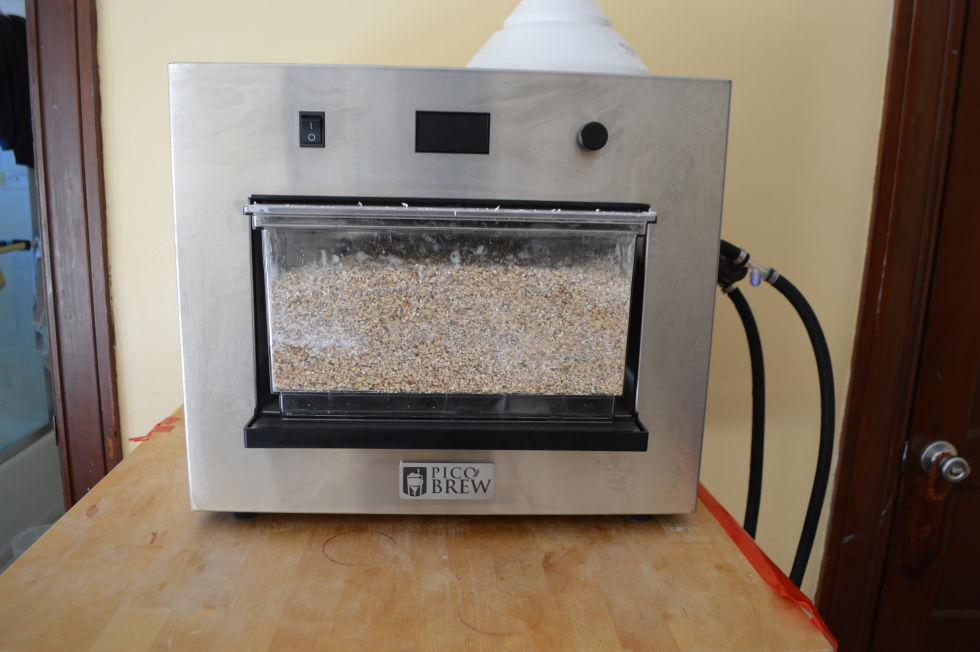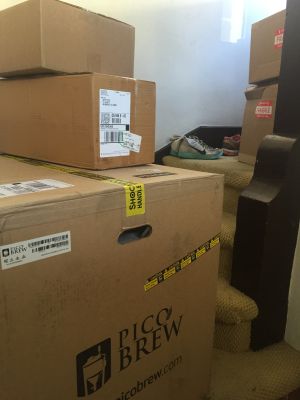
Last month, my husband and I were getting ready to move to another city, and, as often happens when you make big moves, the place was in shambles. Rooms were turned upside down, crucial pieces of furniture were sold way too far in advance of our move (who needs a kitchen table anyway?), and everything we’d ever owned was eyed critically for the garage sale chopping block. In the midst of the chaos, I got a knock on my door from the UPS guy.
"Wait right here," he said breathlessly over the murderous rage my dog was expressing from behind the door. I watched, heart sinking, as he pulled five giant boxes from his truck, one of which was ominously marked “OVER 70 POUNDS.” He wheeled them over to my front steps on a dolly.
"There must be some mistake,” I protested.
"You’re Megan Geuss right?”
Now was not the time for existential quibbling. I signed the guy’s receipt device.
"Are you starting a brewery or something?” he asked. I looked up and I noticed the logo “PicoBrew Zymatic” on the side of the box. It dawned on me that this was the review unit I requested a full seven months ago from a company claiming they had an appliance that could turn brewing beer into a task as simple as brewing coffee. Somehow at the time I had pictured something much smaller and lighter.

I hauled the boxes up the stairs one by one into a house already full of boxes and other crap we were trying to rid ourselves of. I considered just sending the boxes back to PicoBrew. Would I even have the space to set this up? Would I have the time to do a review? Out of curiosity, I opened the first, heaviest box. Wedged in plastic wrap and several pieces of styrofoam, I could see a silver box about the size of an old 20-inch CRT TV. Curiosity got the better of me and I hoisted out it slowly. It looked like a small satellite.
I should mention that I have some experience with beer. Although I'm not an expert, I worked at a brew pub several years ago and took a beer class. I met my husband at said brew pub, and he went on to become the general manager of it, so beer has been a constant in our lives. I have helped home-brew a number of beers, some of which came out tasting awful and some of which came out tasting pretty good. I know how to homebrew the cheap, difficult way, so I figured I should be able to do it the easy, expensive way.
But before we dive into the details of the Zymatic, let’s establish why you’d want to brew your own beer. Brewing beer is pointless and time-consuming to some, so spending money on a rig like the PicoBrew Zymatic would be equally (or more) pointless and dumb to those people. My colleagues and I agree that in general, it’s better to just buy a beer that someone else made than to waste your time trying to brew your own beer if your number one goal is efficiency. Even if the grain and hops are relatively cheap, it’s a time-consuming exercise with a big opportunity cost.
But brewing beer is a fun, crafty thing to do. It’s like knitting. Lots of people knit scarfs and sweaters even though they could probably go out and buy a cheaper/less-time-consuming knit scarf or sweater at Kohl's or something. They do it because it gives them pride to make something and they enjoy the repetitive and detail-oriented nature of the craft. Personally, I hate knitting, but I like brewing beer and writing and cooking and sewing and other little hobby-like things for the same reason people like knitting. Doing these things doesn't always save me money (although sometimes it does) and it certainly never saves me time. I like to do them anyway.At an MSRP of $2,000, the PicoBrew Zymatic is definitely for the kind of hobbyist brewers who have honed their craft to the point where they're really, really good at it. Maybe those brewers want to take things to the next level and do some rapid recipe prototyping before they rent access to big-time brewery equipment. Of course, if could also work for the casual hobbyist who has a ton of disposable income since it’s not a complicated machine to operate. In fact, for all the boxes and components, setup was surprisingly easy and quick (as long as you read the instructions).
You get a big box with the Zymatic and another big box with all the components you use for brewing. Another big box contains a 5-gallon keg that you’ll need to hook up to the Zymatic. PicoBrew also sent us some bottling equipment and pre-packaged ingredients to make a recipe called “Party Porter,” which I eyed with some skepticism. (I don’t know about you, but I’ve lived dozens of years on this Earth by not ever drinking anything labeled “Party Porter.”)
-
A pre-brew Zymatic.Megan Geuss
-
Most of the components that make the Zymatic work come in a separate box, packaged in the drawer that slides into the body of the Zymatic.Megan Geuss
-
Here it is with like half of the trove disassembled.Megan Geuss
-
Dog was very skeptical of the new addition to the family.Megan Geuss
-
Ultimately, this is not a countertop device.Megan Geuss
-
The back of the Zymatic is pretty simple, just plug the Ethernet cable in and you're off.Megan Geuss
-
If you can't get an Ethernet cable to the Zymatic (maybe it's in a basement or something), the machine is Wi-Fi capable.Megan Geuss
-
Ethernet connected!Megan Geuss
-
The ingredients for a Party Porter.Megan Geuss
-
The PicoBrew website lets you glance at all the recipes you've synced to the machine.Megan Geuss
-
Here you get a list of the times the Zymatic was in use.Megan Geuss
-
The recipes I imported and the recipes I created.Megan Geuss
-
You can create your own recipes in PicoBrew's online interface and export it to the Zymatic.Megan Geuss
-
PicoBrew actually has a pretty cool social side, with a nice forum area and an opportunity to see what others around you are brewing. While this function often strikes me as creepy (no thanks, please don't ask me to share my location, Waze), brewing beer seems like an inherently social thing, so I appreciated this.Megan Geuss
Another big component of working with the Zymatic is its online interface. Once I got the hardware set up I plugged an Ethernet cable into the machine and turned to my laptop to check out PicoBrew’s website. It was frictionless to set up a PicoBrew profile and sync my Zymatic to it.
The magic of the Zymatic is that you can select from dozens of recipes, go to the home-brew store, get the necessary ingredients, come home, throw the ingredients into the Zymatic, sync the recipe to your PicoBrew from the website... and in four hours you’ve got a nice wort to pitch your yeast into. Alternatively, you can build your own recipes and sync those to the Zymatic. (Or, you can even use it as a sous vide machine.)
reader comments
76